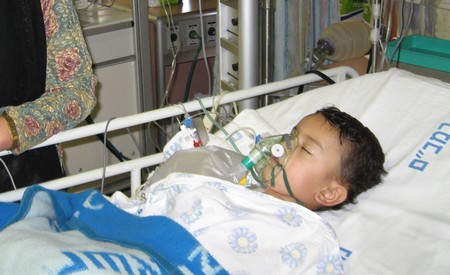Frequently in hospital and sometimes at home a patient may be given oxygen to assist his breathing. Oxygen is supplied in a black and white cylinder. In the home a small size is used, but in hospitals cylinders are stored in a bank away from the ward and the gas is conveyed to the patient along pipes set into the wall. If an atomizer is used, it may be connected to a small oxygen cylinder by the bedside. If you are treating someone with breathing problems and have to constantly change tanks, check these home oxygen concentrators which might be useful.
The oxygen is under considerable pressure inside the cylinder. Because of this, a special valve is fitted, called a reducing valve, which prevents the gas coming out too quickly. The amount of oxygen the patient is receiving is measured in litres per minute by a flow meter. The amount of oxygen in the cylinder is measured by a pressure gauge, indicating full, half full or quarter full.
In hospital oxygen may be given through nasal catheters by face mask, or by placing the patient in an oxygen tent. At home oxygen is most usually given by face mask.
Always observe safety precautions when in the presence of oxygen.
Turning on the oxygen
Check that the cylinder is an oxygen cylinder. Read the pressure gauge to make sure the cylinder contains oxygen. Connect the breathing apparatus to the supply, but do not place it over the patient’s face yet. Open the cylinder with the key and adjust the rate of flow according to instructions (it is measured in litres per minute). Check that the oxygen is flowing by holding the mask near your cheek, then arrange it comfortably for the patient. Record the amount given in litres per minute.
- Check that the cylinder contains oxygen. Connect the apparatus to the supply.
- Open the cylinder and adjust the rate of flow. Hold the mask to your cheek to check that oxygen is flowing.
- Place the mask over the patient’s face so that it fits snugly and comfort-ab|y over his nose and mouth.
Portable oxygen apparatus
Many patients with chronic lung, chest or heart complaints are helped by being able to breathe oxygen when climbing stairs or moving about. In these cases the family doctor will refer the patient to a consultant, who can prescribe the most suitable apparatus which the hospital will then lend to the patient and maintain. You can also get oxygen concentrator advice here.
There are several makes of portable oxygen cylinder available, each supplied with a shoulder strap and carrying bag. They weigh between 2.5 and 5kg each and hold from 100 to 500 litres of oxygen. The patient is also supplied with a gauge and a face mask.
Portable cylinders can be filled from an ordinary oxygen cylinder, with the help of a special recharging adaptor. No special skill is needed and the procedure takes about twelve minutes. Many chemists now operate a while-you-wait refill service, in which case the doctor may prescribe an extra cylinder.
It is possible to buy more sophisticated or elegant pieces of portable oxygen equipment than those available through the National Health Service, but they are generally very expensive.
